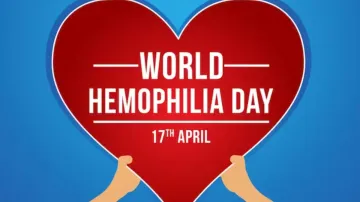World Hemophilia Day 2024: Know causes, symptoms and treatment for inherited bleeding disorder
The severity of hemophilia that a person has is determined by the number of factors in the blood. The lower the amount of the factor, the more likely it is that bleeding will occur which can lead to serious health problems.

Hemophilia is an inherited bleeding disorder in which the blood does not clot properly. This can lead to spontaneous bleeding as well as excessive bleeding following injuries or surgery. Blood contains many proteins called clotting factors that can help to stop bleeding. People with hemophilia have low levels of either factor VIII (8) or factor IX (9).
Causes
According to Dr Archana Swami, Paediatric Hematologist, at Lilavati Hospital Mumbai, hemophilia is caused by a mutation in one of the genes, that provides instructions for making the clotting factor proteins needed to form a blood clot. This change or mutation can prevent the clotting protein from working properly or be missing altogether. These genes are located on the X chromosome. Males have one X and one Y chromosome (XY) and females have two X chromosomes (XX). Males inherit the X chromosome from their mothers and the Y chromosome from their fathers. Females inherit one X chromosome from each parent.
The X chromosome contains many genes that are not present on the Y chromosome. This means that males only have one copy of most of the genes on the X chromosome, whereas females have 2 copies. Thus, males can have a disease like haemophilia if they inherit an affected X chromosome that has a mutation in either the factor VIII or factor IX gene.
A female with one affected X chromosome is a “carrier” of hemophilia-she can pass the affected X chromosome with the clotting factor gene mutation onto her children.
Types
There are several different types of haemophilia. The following two are the most common:
- Hemophilia A (Classic Hemophilia): This type is caused by a lack or decrease of clotting factor VIII.
- Hemophilia B (Christmas Disease): This type is caused by a lack or decrease of clotting factor IX.
Signs and Symptoms
Common signs of haemophilia include:
- Bleeding into the joints. This can cause swelling and pain or tightness in the joints; it often affects the knees, elbows, and ankles.
- Bleeding into the skin (which is bruising) or muscle and soft tissue causes a build-up of blood in the area (called a hematoma).
- Bleeding of the mouth and gums, and bleeding that is hard to stop after losing a tooth.
- Bleeding after circumcision (surgery performed on male babies to remove the hood of skin, called the foreskin, covering the head of the penis).
- Bleeding after having shots, such as vaccinations.
- Bleeding in the head of an infant after a difficult delivery.
- Blood in the urine or stool.
- Frequent and hard-to-stop nosebleeds.
Who is Affected?
Hemophilia affects people from all racial and ethnic groups.
Diagnosis
Many people who have or have had family members with hemophilia will ask that their babies get tested soon after birth. About one-third of babies who are diagnosed with haemophilia have a new mutation not present in other family members. In these cases, a doctor might check for hemophilia if a newborn is showing certain signs of hemophilia.
To make a diagnosis, doctors would perform certain blood tests to show if the blood is clotting properly. If it does not, then they would do clotting factor tests, also called factor assays, to diagnose the cause of the bleeding disorder. These blood tests would show the type of hemophilia and the severity.
Treatment
The best way to treat haemophilia is to replace the missing blood clotting factor so that the blood can clot properly. This is done by infusing (administering through a vein) commercially prepared factor concentrates. People with hemophilia can learn how to perform these infusions themselves so that they can stop bleeding episodes and, by performing the infusions regularly (called a prophylaxis), can even prevent most bleeding episodes.
Good quality medical care from doctors and nurses who know a lot about the disorder can help prevent some serious problems. Often the best choice for care is to visit a comprehensive Hemophilia Treatment centre that not only provides care to address all issues related to the disorder but also provides health education that helps people with hemophilia stay healthy.